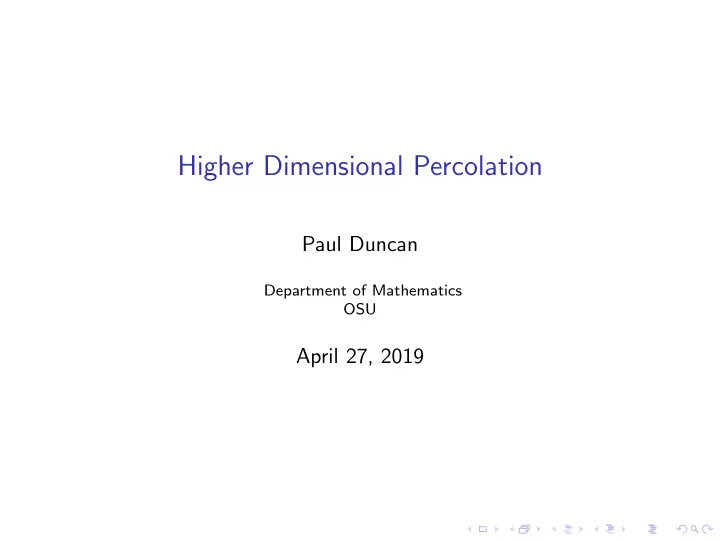

Higher Dimensional Percolation Paul Duncan Department of Mathematics OSU April 27, 2019
Bond Percolation ◮ Consider the integer lattice obtained by connected each vertex in Z d ⊂ R 3 to its nearest neighbors. We can construct a random subgraph by starting with Z d and adding each possible edge with probability p independently. ◮ A classical problem is to find the threshold for p , called p c ( Z d ) at which an infinite connected component appears with positive probability.
Bond Percolation ◮ Consider the integer lattice obtained by connected each vertex in Z d ⊂ R 3 to its nearest neighbors. We can construct a random subgraph by starting with Z d and adding each possible edge with probability p independently. ◮ A classical problem is to find the threshold for p , called p c ( Z d ) at which an infinite connected component appears with positive probability.
Plaquette Percolation ◮ Construct a random complex by starting with the full integer lattice and adding 2-dimensional faces with probability p independently. Theorem (Aizenman, Chayes, Chayes, Fr¨ olich, Russo) Let γ be a planar rectangular loop in the integer lattice L ⊂ R 3 , and let W γ be the event that there is a plaquette surface with γ as its boundary. Then we have � p < 1 − p c ( Z 3 ) exp( − α ( p ) Area ( γ )) P ( W γ ) ∼ p > 1 − p c ( Z 3 ) exp( − β ( p ) Per ( γ )) for some 0 < α ( p ) , β ( p ) < ∞ . ◮
Plaquette Percolation ◮ Construct a random complex by starting with the full integer lattice and adding 2-dimensional faces with probability p independently. Theorem (Aizenman, Chayes, Chayes, Fr¨ olich, Russo) Let γ be a planar rectangular loop in the integer lattice L ⊂ R 3 , and let W γ be the event that there is a plaquette surface with γ as its boundary. Then we have � p < 1 − p c ( Z 3 ) exp( − α ( p ) Area ( γ )) P ( W γ ) ∼ p > 1 − p c ( Z 3 ) exp( − β ( p ) Per ( γ )) for some 0 < α ( p ) , β ( p ) < ∞ . ◮
Recommend
More recommend